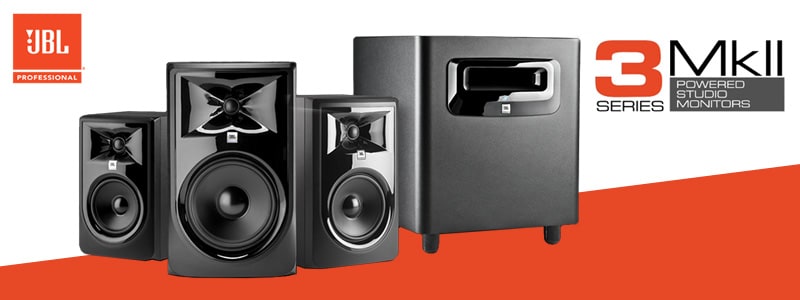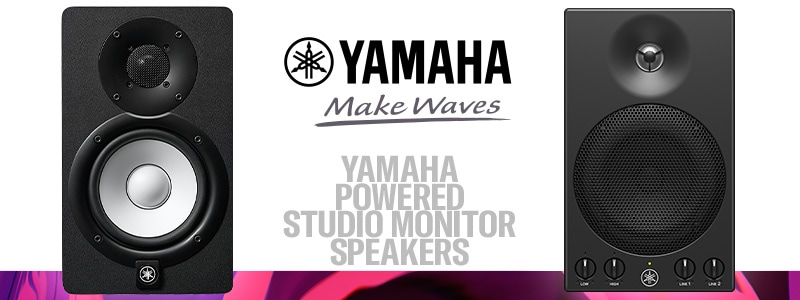
- SPECIAL SELECTION
- How to Choose Studio Monitors
How to Choose Studio Monitors
Studio monitors are a must-have item for making music with computers and DAWs. While general audio speakers are for enjoying the sound, studio monitors should have high reproduction ability and flat frequency response that accurately reproduce the original sound in detail.
Of course, listening with headphones is also necessary and important, but listening to the actual sound coming out of the speakers helps the listener to accurately identify the localization (position of each sound source) of the sound recorded in stereo, so the listener can then accurately check the overall balance.
Choose from well-established manufacturers
When you purchase studio monitors for the first time, you may not be able to decide what kind to choose because there are many manufacturers and models. If this is the case, then maybe consider a good popular model from a reputable manufacturer.
Choose by size
Speaker size should be selected according to the amount of necessary space. The larger the size, the higher the low-frequency reproduction capability, and the more powerful the sound. However, since the size is also bigger, you will need a space to turn up the volume and bring out its tone colors, so it’s important to select a size that’s suitable for the environment.
If you can’t decide, we recommend our best-selling 5-inch speakers.
Choose by output wattage
Choose by price
Choose according to input terminal
Currently, mainstream studio monitors are powered with a built-in power amplifier. The types of input terminals are XLR, TRS/TS phone, RCA, and stereo mini, so choose one that matches with the correct output device. In addition, some models use different input terminals depending on the input signal of -10dBv (consumer equipment level) and +4dBu (commercial equipment level).
Compare sample sound sources
At Sound House, we have compiled a library of sound samples that have been recorded onto the standard models. The same sound source and recorder together create their own subtle nuances in tone colors due to various sizes and manufacturers.
Make sure to compare different sizes and makers of different studio monitors.
Take advantage of the adjustable lows and highs to suit your environment.
Room size and acoustic characteristics can have a significant effect on sound. Some models feature a controllable low-frequency boost that occurs when the studio monitors are placed directly on a desk or near the wall. The high frequencies can also be adjusted for balance.

Left:JBL 3 series MkII → Boundary EQ、HF TRIM
Right:YAMAHA HS Series → ROOM CONTROL、HIGH TRIM
Add a subwoofer for studio monitors
The manufacturers and model series which are considered the standard will have a lineup of subwoofers and speakers that reproduce only low frequencies. Add a subwoofer to your speaker system and you will be able to check the thickness and power of the bass that cannot be reproduced by full-range speakers only. In addition, full-range speakers don’t need to produce a full bass range because the subwoofer is providing it. The full-range speakers will then be free to efficiently produce the mid-high range.
We recommend adding a subwoofer to those who want to feel the vivid bass vibrations rather than feeling the music using your ears only.


In a stereo system, the subwoofer is placed between the two main speakers. The amount of bass you can hear depends on how the speakers are placed. Below is a suggested image how the speakers can be placed, but you can change the bass volume according to how you like.
How to hear more accurate speaker sounds
1Install it correctly.
In order to maximize the performance of the speaker and be able to listen to it with better quality sound, you will need to set apart the speakers accordingly. Yamaha, manufacturer of the standard studio monitor HS series and MSP series, is providing the following advice on recommended speaker distance.
モニタースピーカーの設置(より良い音で聞くために)

モニタースピーカーの設置にはいくつかのポイントがあります。
■ポイント1
<壁やコーナーから1.5m以上離れた場所に設置が理想>
壁やコーナーから1.5m以上離れた場所に設置が理想的です。
壁や部屋のコーナーに近づけば近づくほど、壁からの音の反射によってスピーカーの低音が強調されやすくなります。壁からの距離を確保できない場合は、ROOM CONTROLスイッチを使って、スピーカーの低音が強調されるのを補正してください。壁に近づくにつれて、ROOM CONTROLスイッチを「0」→「-2」→「-4」にすると、自然な低音になります。
■ポイント2
<左右対称に設置>
左右対称にスピーカーを設置することをおすすめします。スピーカーから壁までの距離を同一にしてください。
■ポイント3
<自分の位置と正三角形を作るように設置>
スピーカー2台と自分の位置(リスニングポイント)の3点で正三角形を作るようにします。また、スピーカーのフロントパネルを自分の方向に向けてください。
■ポイント4
<ツイーターと耳の高さを合わせて設置>
ツイーターと自分の耳が並ぶ高さにスピーカーを設置してください。より正確なモニタリングが出来るようになります。
POINT
- 1. Place a pair of speakers symmetrically on your left and right, and the speakers should form the same distance from your ears to both speakers. Speakers should also be the same distance apart as well.
- 2. Place the tweeters at a height that is level with your ears.
2Place the speakers at a height that is level with your ears.
Studio monitor stands will help desktop placement and floor placement.
This desktop speaker stand is reasonably priced and well made.
If you place a speaker directly on your desk, it may be a little lower than your ears’ height. We recommend the MST Speaker Stand when you need to raise the height of the speaker a little.
- ■Height: 21 cm (including pad)
- ■Top plate size: 21 x 24 cm
- ■Base plate size: 21 x 24 cm
This is recommended for floor-standing type stands!
This one is also made of sturdy steel and can adjust to 5 levels. One good feature is that the screw and pin can easily adjust a pair of stands at the same height. You can’t miss the included insulator!
- ■Height: 96.5-136 cm
- ■Top plate size: 23 x 23 cm
This floor speaker stand can be set slightly lower than the MST20. Accessories such as pads, height adjusters, and spikes are included. The height can be finely adjusted to 16 levels!!
- ■Height: 74-114 cm
- ■Top plate size: 23 x 23 cm
The Classic Pro / MST40 has two columns to create high stability and is compatible with small to medium size speakers.
A great feature is that the base plate is smaller than other speaker floor stands, so you can save up the space.
- ■Height: 80-81.5 cm
- ■Top plate size: 23 x 23 cm
- ■Base plate size: 30 x 25 cm
3Use isolation pads and insulators.
Even if your mixer, microphone, preamp, cables and other equipment are excellent, if you don’t separate the monitor speakers from the surroundings, you will not be able to hear what you actually recorded. Isolation pads and insulators shut out the excess sound waves between the monitor speakers and the objects in contact with the monitor, and improve the accuracy of the entire monitoring system.

With the included MoPAD Wedge Adjusters, 5 tilt options (-8°, -4°, 0°, +4°, +8°) are available.
- ■4 pads for a pair of stereo speakers
- ■2 pads support one monitor speaker.
- ■Dimensions: approx. 10 (W) x 30 (D) x max. 4.5, min. 2.5 (H) cm
- ■Weight limit: 100 lbs (approx. 45 kg)
List of Auralex Isolation Pads

The AT6099 is a hybrid insulator set that uses special anti-vibration rubber.
- ■Type: Hybrid insulator, set of 6
- ■Structure: 4-layer hybrid structure (honeynite/brass/honeynite/sorbothane)
- ■Dimensions: φ30 × 17 mm
- ■Weight: approx. 65 g (1 piece)
- ■Weight limit: 5 kg (per unit/uniform static load resistance)
- ■Accessory: 6 x spacer
4 Adjustable volume at your fingertips
Many powered studio monitors have a volume knob on the back panel. When controlling the volume, turn the knob on the back or control the knob from the connected devices such as an audio interface and a mixer.
However, this JBL / M-Patch 2 monitor switch (volume controller) allows you to easily adjust between the audio interface/mixer and the speakers while you have full easy access to adjust the volume of a pair of speakers at the same time, which can be done all from the comfort of your chair.

























